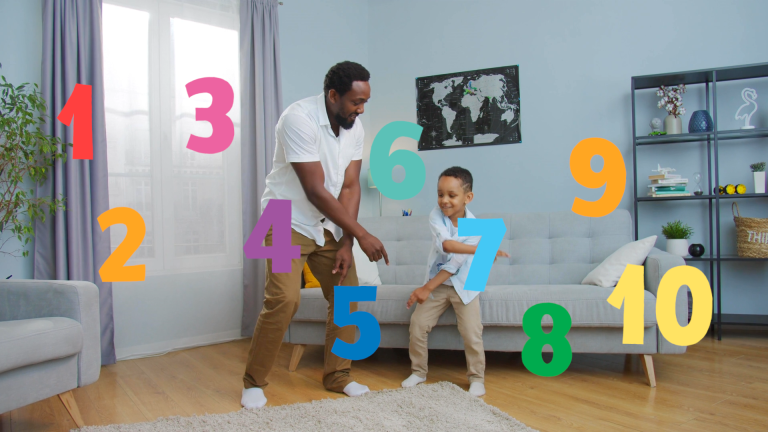3 Thanksgiving Math Games to Practice Estimating, Counting and Subitizing
Aside from pumpkin pie, stuffing and gravy, Thanksgiving reminds us to think about what we are grateful for, especially the people we are fortunate to call our family and friends. It’s also a wonderful time of year to play and learn together. We’ve rounded up three turkey-inspired games that will give early learners a chance to gobble their way through practicing estimating, counting, one-to-one correspondence and subitizing. Use the tips to start math conversations with your children.

One-to-one correspondence means matching numbers to specific quantities.
Subitizing skills are developed as children become able to recognize quantities of numbers without counting them.
Thanksgiving Estimation Jars
Try your hand at this guessing game featuring turkeys and pom-poms! Practice estimating and guessing in this crafty activity from PBS KIDS for Parents. The object of the game is to guess how many pom-poms are in each jar. You’ll need three colors of foam, felt, or construction paper, googly eyes, scissors, 3 glass jars or clear cups of different sizes, tape, pom-poms, a pencil and paper. Use the foam or felt to cut out three turkey heads, 3 wattles (the red part that dangles from a turkey’s chin) and 3 beaks. Your turkeys can be different sizes too!
Use double-sided tape or glue to attach all the pieces together. Then tape one turkey head outside of each of the glass jars or cups. Grab a handful of pom-poms to fill up each jar.
Set up a sheet of paper by drawing one vertical line down the middle to create two columns. Then draw two horizontal lines across to create six boxes in total. Record your estimates for each jar in the first column and record the actual number of pom-poms in the second column. After you make your first estimation, take the pom-poms out and count! How close were you to your estimation? Now make an estimation for the second jar and third jar.

Tip: Have a conversation about how knowing the actual amount in one jar could help make better or more accurate estimates for the other jars. For example, if you estimated the biggest jar to have 20 pom-poms, but there were actually only 12 pom-poms, would you estimate that the smallest jar had more or less than 12 pom-poms?
Fill the jars with new amounts of pom-poms and keep playing!
Tip: Talk about your strategies for estimating. As you keep making new estimations, are your estimations getting closer? How do the sizes of the jars help you determine how much to estimate? Does it help to count the pom-poms you can see from outside the jar and use that number to estimate the total amount? As you continue playing, how do the actual numbers of pom-poms change?
Feed the Turkey Game
Practice counting, one-to-one correspondence and subitizing in this fun turkey feeding game from Fun Learning for Kids. You’ll need a paper bag, three colors of construction paper, a marker, glue or tape, scissors, a pair of dice and something to feed the turkey. Get creative with your turkey’s favorite food! Wild turkeys typically eat acorns, but you can use candy, popcorn or even your favorite cereal.
Start by making your turkey! Use the different colors of construction paper to make your feathers. Cut out pieces for the turkey’s beak and wattle.
Tip: As you cut out the feathers, beak and wattle, talk about if any of them are familiar shapes and take the opportunity to name them.
Cut a hole in the front of the bag. This is your turkey’s mouth. Draw eyes on the bag and glue on the feathers to the top of the bag. Glue on the beak and wattle too. Add other festive decorations to your turkey such as a bow, hat or necktie!
Now you can start feeding the turkey! Roll the dice and identify the number it lands on. Then carefully count out that number of turkey food, one by one, and place it into the turkey’s mouth. For extra practice, count out a pile of the food first, then count the food again as you feed the turkey. After a few rounds, you can empty the bag and start over again. If you’re playing with someone else, compare the amounts of turkey food in the bag at the end of each round. Whose turkey was hungrier?
Tip: Use one die for children who are new to counting. Use a pair of dice when children can count past six.
Turkey Cups Fine Motor Math Game
Practice counting and subitizing in this math game by Pre-K Pages that will also help young learners develop fine motor skills and hand-eye coordination. You’ll need disposable paper cups, pipe cleaners, dice, beads, tape and scissors. You can find a free printable turkey online draw your own.
Start by poking several holes in the bottom of each cup with a pen or scissors. Now add the turkey “feathers.” Fold each pipe cleaner in half and insert the pipe cleaners into the holes, with the folded side inside the cup. Tape or draw a turkey on each cup. Each player will receive one cup and take turns rolling the dice. Count out loud as you add the corresponding number of beads onto the pipe cleaners. Keep rolling and taking turns until all the feathers are filled with beads.
Tip: Picking up and placing beads on the pipe cleaners helps children develop fine motor skills and hand-eye coordination because they are handling very small objects.
For an added challenge, count up all the beads at the end of the game. Whose turkey has the most beads? Whose turkey has the least number of beads? You can remove the beads and play the game again.





